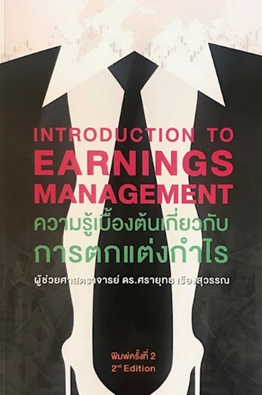Co-created by
Ms. Thipvipha Pupipatphol (Intern)
Mr. Chaiwat Hanpitakpong
(Economist, Professional Level at Division of Financial Inclusion Policy and Development)
1. Introduction
Financial statements serve an essential part in the decision-making process of investors, providing a comprehensive overview of a company’s financial stance, performance, and insights into its financial standing. Accordingly, creative accounting, which involves modifying financial information may pose repercussions for investors, which means altering the actual financial outcomes might mislead investors and affect their processes for making decisions. On top of that, the following written content addresses an occurrence that has a possibility to impact confidence in the capital market and bond market, ultimately impacting the stability of the Thai economy.
2. Stock Exchange of Thailand
According to the information on July 1, 2023, the market capitalization of the Stock Exchange of Thailand amounts to 19 trillion baht, positioning it as the second largest market in the ASEAN area by trailing only Singapore and also ranks as the 25th largest market globally. The listed company in Thailand encompasses 324 companies, comprising 118 companies listed on the Stock Exchange of Thailand (SET) and 206 listed on the Market for Alternative Investment (MAI), they assume a significant role in propelling the Thai economy as a funding source for enterprises aiming to augment their operations. The occurrence of creative accounting in a listed company has a significant impact on investor sentiment within the stock market and might lead investors to divert their investments to other countries, thereby impeding the company’s ability to secure funds for the purpose of expanding its company operations in Thailand.
3. The impact of creative accounting on investor confidence and stability of the Thai economy
Creative accounting refers to the practice of deliberately manipulating financial information by management in order to present a more favorable picture of a company’s financial performance. This process involves the strategic use of accounting techniques to alter accounting numbers and misrepresent the true financial position of the organization. The objective behind creative accounting is the manipulation of financial statements through the strategic utilization of accounting standards and the various options available for measuring or disclosing accounting information enable management to present financial reports that align with their desired outcomes. In recent times, there has been regarded for a listed company’s financial statement garnering concern from investors. This issue inspires the Macroeconomic Policy Division, collaborated with Fiscal and Finance Journal and FPO Knowledge Management team, hosted a Local Reach Interview special episode on July 21st, 2023, with the overarching theme of “The Impact of Creative Accounting on Investor Confidence and The Stability of The Thai Economy.” In this regard, the interview programme received the honour from the Esteemed guest speaker, Assoc. Prof. Somchai Supattarakul (Ph.d), who holds the position of Dean at the Faculty of Commerce and Accountancy, Thammasat University participated in the 1-hour interview.

Dean at the Faculty of Commerce and Accountancy, Thammasat University
4. Differences between Earning Management VS Accounting Frauds VS Corporate Fraud
Initially, Assoc.Prof.Somchai presents the overview of differences between earnings management, accounting frauds and corporate fraud. Then, we could understand that there are several practices of creative accounting with differing degrees of severity. The least severe form is Earning Management, a technique that involves the strategic manipulation of financial accounts through the utilization of accounting flexibility to distort numerical values. It is important to bear in mind that while this form falls within the boundaries set by accounting standards, it is still deemed inappropriate and should be avoided. Meanwhile, accounting fraud is a deceptive practice that involves manipulating financial data to create a false impression of favorable outcomes by fabricating sales that are non-existent and unlikely to materialize in the future and considered to be more serious severity compared to earnings management.
Nevertheless, it ought to note that instances of embezzlement are not anticipated in this scenario and the organization can continue its operations without incurring any monetary setbacks, however, the stock price may still be influenced. In addition, there is a more severe form of accounting fraud known as corporate fraud, whereby money is embezzled from a company, which could negatively impact operations resulting in the loss of company performance. In certain instances, the capacity to settle outstanding debts may be weakened, potentially leading to the closure of the company, therefore, leading to inflict more damage on the company and its stakeholders compared to the aforementioned forms of damage.
All forms of creative accounting impact financial information as they involve modifying the financial statements. Still, there are varying degrees of severity, which mean Earning Management can be permitted within the framework of accounting standards without fraud, while Accounting Fraud and Corporate Fraud are similar, but Corporate Fraud is more severe and may cause much more damage to the company.
5. Basic Earning Management Tactics
Moreover, Assoc.Prof.Somchai also mentions the idea of earning management techniques by presenting that the tactics are made by the implementation of accounting flexibility. The company can provide management with the discretion to make modifications to manipulate financial statements within the accounting standard boundaries, contingent upon the specific circumstances and organizational context of each company which includes;
Valuation Allowance or Accounting Reserves, as provisions set aside by companies to account for potential losses or uncertainties in their financial statements, consist of two categories, namely Cookie Jar Reserves and Big Bath Charges. To begin with, Cookie Jar Reserves refer to the practice of deliberately overestimating expenses or underestimating revenues in order to create a reserve that can be utilized to smooth out future Excessive Loss. Whilst, Big Bath Charges is the ploy to exacerbate the currently unfavorable performance of a company, as its subpar financial standing and inability to generate profits through other ways, consequently of the disastrous company’s financial status circumstances, then investors generally express their discontentment. The main purpose of utilizing this method is to strategically position the company in a manner to appear to yield an enhanced trend of profit growth prospects continually in the foreseeable future.
Accounting Methods or Estimations, these methods may not yield commensurate financial outcomes when compared to different approaches, such as the modification of accounting policies pertaining to inventory valuation. This methodology is frequently observed in cases wherein the firm seeks to attain a modest level of profitability.
Real Economic Decisions, these techniques are alterations in company strategies, exemplified by the deferral of maintenance or advertising expenditures from the concluding months of the current fiscal year to the initial months of the subsequent fiscal year, with the aim of augmenting profits within the present year. The methodology actually be used for more than merely enhancing numerical gains, it also encompasses a shift in the strategic choices made by businesses.
Premature Revenue Recognition, the approach is widely recognized as means by which to enhance one’s financial gains, as it yields a significant augmentation in numerical figures and frequently entails expediting the recognition of transactional aspects of the sale. This can be achieved through the establishment of specific conditions that enable to accelerate the recognition of accounting revenue or through the interpretation of accounting standards and it is imperative for entities to adhere to the principle of recognizing revenue on an accrual basis, irrespective of receiving real cash because the recognition of sales revenue is contingent upon the completion of work and the delivery of the product. In the case that there is a desire to expedite the recognition of next year’s projected revenue into the current fiscal year, the establishment of revenue recognition criteria may necessitate the implementation of certain conditions. For instance, subsequent to the sale and delivery of products to customers, a condition may be imposed wherein the product can be returned if the customer expresses dissatisfaction, therefore this scenario, the recognition of the revenue is impeded by the existence of a return guarantee, despite the product not being in possession of the company, revenue recognition is withheld, as accounting standard boundaries.
6. Differences Between Premature Revenue Recognition VS Fictitious Revenue Recognition
In addition, Assoc.Prof.Somchai tries to elaborate the idea of revenue recognition which both approaches indicate similarities in the creative accounting techniques, nonetheless, these vary in terms of severity. The practice of Premature Revenue Recognition involves bringing future income within the financial statements of the current fiscal year by aligning to accounting standards boundaries.
On the other hand, the act of Fictitious Revenue Recognition refers to the deliberate manipulation or fabrication of revenue figures within a company’s financial statements to serve as a deceptive mechanism to create an illusion of enhanced financial performance. Additionally, Fictitious Revenue Recognition is not classified within the realm of Earning Management Tactics and is regarded as a manifestation of accounting fraud due to its excessive severity, thereby surpassing the boundaries set forth by accounting standards.
7. Hierarchical Earning Targets
The main reason for the practice of creative accounting in firms is to achieve their financial goal. Firstly, it entails ensuring that profits remain positive and avoiding losses through the strategic utilization of accounting flexibility to enhance profit. The second is the Pattern of Earning Growth, which makes the company’s performance lucrative with a propensity to constantly improve. Lastly, tackle to reach Analysts’ Forecasts or Management’s Forecasts, which is imperative to align with the prognostications of analysts or the earnings forecast announcements made by the management.
8. STARK’s creative accounting: a case study
Finally, Assoc.Prof. Somchai shed a light on the hot issue, STARK Corporation, which happened recently and also link the prior-idea with the story. By telling the background, STARK Corporation Public Company Limited has invested in Vietnam, a rapidly growing market resulting in outstanding company performance. The desired outcome of this endeavor is to attain a financial target of about thirty billion baht surpassing the existing of approximately twenty-seven billion baht. Subsequently, a noteworthy occurrence that aroused suspicions among investors, transpired in the form of the resignation of senior executives, board members, and auditors.
Furthermore, Assoc.Prof.Somchai adds that .when the company attempted to release its financial statements for the fiscal year 2022, it encountered an impediment that prevented the prompt submission of declared statements to the Stock Exchange of Thailand leading to the temporary suspension of investing for STARK indicated as SP, garnered significant suspicion from investors due to the potential particulars that may impede the company’s timely submission of financial statements. Afterward, the company conveyed the imperative to effectuate a modification in the composition of the managerial cadre, confessing the fraudulent activities within the organization, it was revealed, had engendered a distortion in the veracity of the financial statement over the preceding period, which the auditor declared the audit results as a “Disclaimer of Opinion”. The auditor decision is reached after the regulatory, including stock exchanges, credit rating firms, equity and debenture funds, and the Securities and Exchange Commission issued several actions.
A comprehensive investigation ultimately revealed that the financial records of STARK Corporation had been subject to fraudulent activity, wherein counterfeit income was being generated within its subsidiary entities and the spurious trade accounts receivable arises from the absence of actual transactions. The company’s financial statement was distorted for several years, resulting in the performance seemingly exhibiting a notable upward trend in profitability over the course of many consecutive years. Specifically, the profit before the year 2021 amounted to approximately 593 million baht, which experienced a substantial increase to approximately 1,763 million baht in the year 2021. Furthermore, the profit continued to soar in the subsequent year, reaching an impressive figure of approximately 5,399 million baht in the year 2022.
In order to mitigate the abnormally high account receivable from defalcation, the funds were withdrawn from the company and subsequently allocated toward the repayment of the fictitious debtor’s outstanding debt and advance payment for counterfeit goods, which was intended to facilitate the extraction of funds from the company in the period of the fiscal year 2022, with a substantial sum of approximately 10,451 million baht being involved. In this aspect, Assoc.Prof.Somchai summarises that the STARK company’s fraudulent activity is classified as corporate fraud, which is the most serious severity degree of creative accounting.
9. The regaining of investor confidence
Before ending the interview, Assoc.Prof.Somchai also propose the recommendations to the authorities related to this issues. The instances mentioned above have contributed to a decline in confidence among investors in utilizing financial statement information for making investment decisions, thus, this has given rise to information risk, which is recognized as a form of risk that leads to an elevated cost of capital. Assoc.Prof.Somchai emphasizes that the regaining of investor confidence is a crucial process in the capital market and he also provides recommendations for policy implementation as followings:
The adequacy of the internal control process has to be evaluated. The entity’s established internal control methods are mainly intended to prevent fraudulent activities perpetrated by operators. Inadequate measures to mitigate fraud among senior executives because the high-level executives have the ability to authorize, there is unable to avoid corruption if, for example, the CEO and CFO commit it simultaneously. In instances where these individuals engage in corrupt practices jointly, the prevention of such misconduct becomes exceedingly challenging. That’s why, it is imperative to employ stricter legal measures in order to effectively combat corruption perpetrated by top-level executives.
Enhance the Auditing standards, and improve the ability of auditors to detect fraud investigation through the special audit. The in-depth investigation results in higher audit fees and causes lower profits for the company. This practice increases costs for non-risked fraud companies and places greater responsibility on auditors, potentially leading to difficulties in finding auditors.
Review the role of internal auditors and the audit committee, to enrich the functions and responsibilities in the context of enhancing the effectiveness of evaluating the internal oversight process.
Enhance the function of regulators, like the Securities and Exchange Commission (SEC) and the Thai Stock Exchange (SET) through developing methods to detect fraud from the information which has been submitted to authorities ongoing basis by the corporate, without the need for an auditor result. Consequently, strong governance and the implementation of practices for preventing defalcation are able to identify fraud more rapidly and reduce the extent of the damage.
Establish an investor relief fund, there similar to the Deposit Insurance Fund as an approach is able to alleviate investors’ concerns, yet there is not much impact on increasing their confidence. On the other hand, investors may neglect to consider the investing risks which the manner is called a ” Moral Hazard”.
10. Summary
The Stock Exchange of Thailand is a significant source of funding surpassing the bond market and bank lending, known as the Thai economy immensely relies on. The occurrences that involve manipulating the company’s account on the stock exchange do have negative repercussions on investor confidence leading to losing its attractiveness, resulting in the investors may turn to invest in the foreign stocks exchange instead. Such could have a bearing on Thailand’s economic growth, thereby regaining investor confidences have to be needed, agencies suppose to accelerate the implementation strategies, nonetheless, they ought to contemplate the possibility of consequences for all facets. Last but not least, Assoc.Prof.Somchai told that readers who want to learn more about earning management, can read “the Introduction to Earnings Management” authored by Assoc.Prof. Sarayut Rueangsuwan (Ph.d). Above all, we thank Assoc.Prof. Somchai Supattarakul (Ph.d) again for giving us a time and and, we truly appreciate Mr. Pisit Puapun (Ph.d), Mr. Norabajra Asava-vallobh (Ph.d), for inspiring this wonderful programme.



Ms. Thipvipha Pupipatphol
Intern at Macroeconomic Policy Division
Fiscal Policy Office
ผู้เขียน

Mr. Chaiwat Hanpitakpong
Economist, Professional Level
at Division of Financial Inclusion Policy and Development
ผู้เขียน
